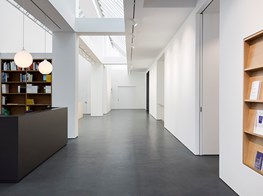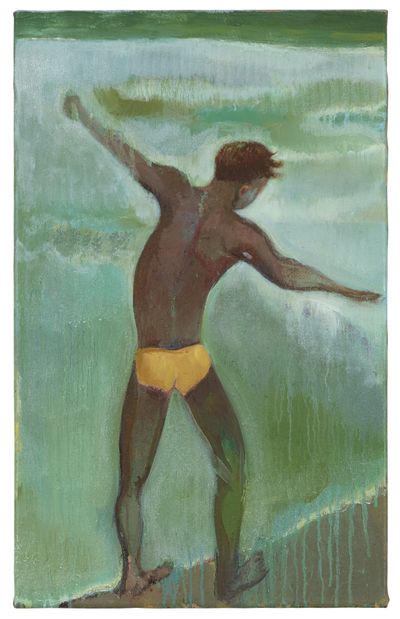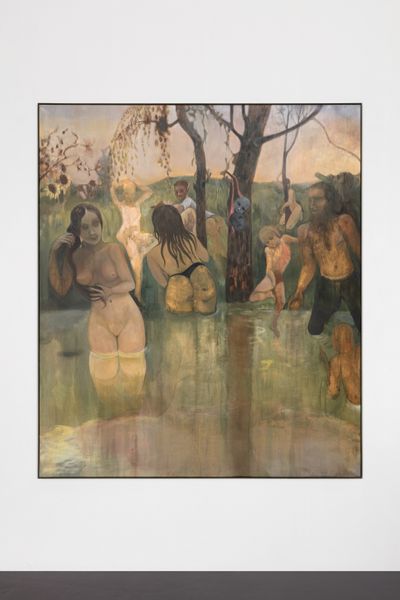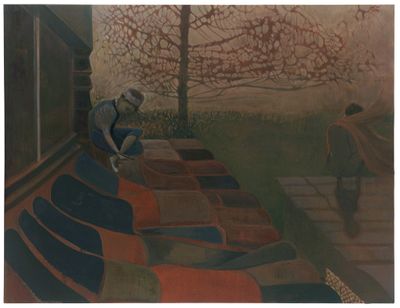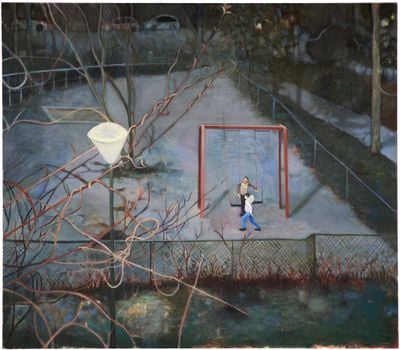
Following a busy year of fair participations alongside solo and group exhibitions, and with Esther Schipper having announced her representation in September, Sarah Buckner is on a roll for 2022. The Cologne-based painter reflects on her practice thus far with Ocula Advisory correspondent Will Hine.
You attended the Accademia di Belle Arti in Palermo from 2006 to 2008, the Kunstakademie Düsseldorf between 2009 and 2017, and spent some time at the California College of Arts, San Francisco in 2014.
How did your experiences at institutions in Italy, Germany, and the U.S.A. shape your practice?
Everything I have ever seen and all the places I visit shape me. I travelled a lot during and after my studies, including trips to the U.S., Morocco, Peru, Bolivia, and Trinidad.
I was struck by each place differently, but it was my repeated visits to Italy that probably impacted me most. In the U.S., it was primarily the vastness of nature, and in Italy, the urban centres and amazing frescos.
Certainly, my time at the academy in Düsseldorf studying under Peter Doig was very important for my artistic development, but there are so many things that have influenced me and my work.
I think what affected me most were the encounters—the people I met during that time. Again, it was not one thing that affected me, but the full package.
You also completed a residency earlier this year in Münster, which culminated in your solo show Head over Heels at the Westfälischer Kunstverein.
Do you find that the geographical context in which you're working influences the imagery you paint?
Yes, it does. The place and the life there become part of my work in some way. The geographical context influences my work, which then develops organically.
Your paintings often have a dreamlike quality, with each composition appearing almost like a fragment of a larger story, though the narrative is never explicit.
I'm curious to know how much planning goes into each painting, or whether the process of image-making for you is spontaneous?
Yes, the dreamy quality is intentional; doesn't life sometimes seem unreal, or like you're dreaming?
Preparation doesn't always work for me—it really depends on the situation. My paintings go through a lot of changes, and the dreamlike atmosphere arises on its own.
Sometimes, I discard a big part of the painting and the real painting emerges. Untitled (Bacchanal) is a good example.
For the works presented at the Westfälischer Kunstverein, I used photographs I took of friends going for a swim to make watercolour sketches and stencils of the figures, as preparation. This resulted in a small group of paintings on the same subject.
Since our first lockdown in 2020, my practice has changed. Now it's more direct than ever. To get into that right painting mood, I need to read. From there, it is a spontaneous process in which chance is certainly a factor.
It's an intense period, sometimes bringing up feelings of shame or inhibition—it is never an easy process.
I also wanted to talk about your technique. In some of your recent works, you use oil paint in a way that is sometimes similar to that of watercolours or even pastels, suffusing the surfaces with a kind of hazy atmosphere.
Is that something you've deliberately tried to achieve in the newer works, or something that has developed slowly over time?
My technique depends on the subject. I like the haziness when it fits the motif.
The effect depends on how I apply the paint and how I prime the linen. Sometimes I dilute my paint and let it flow, while at other times it needs to be more controlled.
Although it's not always immediately visible, there are many layers of paint. These are some of the advantages of oil paint.
Over the years, I have developed my own personal palette, which of course continues to evolve. It's important to me to find the right tones to 'sing the song' I want to sing, so to speak.
Your use of colour also lends the paintings that almost otherworldly quality. At times they are slightly saturated, and at others more muted, but rarely, if ever, naturalistic.
It leads to a very distinct depiction of light, which separates the pictures from a clear sense of time or place, though, to me, it often seems like the paintings depict scenes happening late at night or in the very early hours of the morning. Is that something you consider when making the works?
Each painting has a different background. For example, for Midnight, a lot of the impressions came from the early morning hours between night and day. In that case, I was observing a tree outside my bedroom.
Beyond observations, there is also a lot of imagination in my paintings. There are things that suddenly appear within them, a certain magic...
The otherworldly quality that you mention is intentional, and the space that you may be referring to—the background noises, what we call Nebengeräusche in German—can describe many different things at the same time.
I noticed in a few of your paintings that you depict children or young adults. I understand you often draw on literature and film and wondered if you are making reference to something specific?
My attitude towards life is that of a young person, so I am probably more driven towards depicting youth in my works.
Kinderhaus, for example, was inspired by a scene of some children outside my studio window, who I really liked observing. The building in the background is the studio building of the Münster residency.
When the painting was finished, Jean Cocteau's book Les Enfants Terribles (1929) came to mind, because unfortunately the children were disturbing me while I was trying to concentrate on my work in the studio. A movie that hit me in this regard was the 1961 classic, The Innocents by Jack Clayton.
These films and books that I mention are not intentional references, rather things I'm occupied with in and around the time I develop a specific painting.
You recently joined Esther Schipper gallery, where you exhibited earlier this year in their group show, L'Invitation au voyage. Can you tell us about any plans for future exhibitions at the gallery?
There will collaborations with Esther Schipper and for other projects, but this will take a while, since all good things come to those who wait.
I don't want to tempt fate by speaking of uncompleted paintings, so let's keep them a surprise. —[O]
Main image: Sarah Buckner, Datura (2021). Oil on canvas. 27 x 35 cm. Courtesy Esther Schipper. Photo: © Andrea Rossetti.


